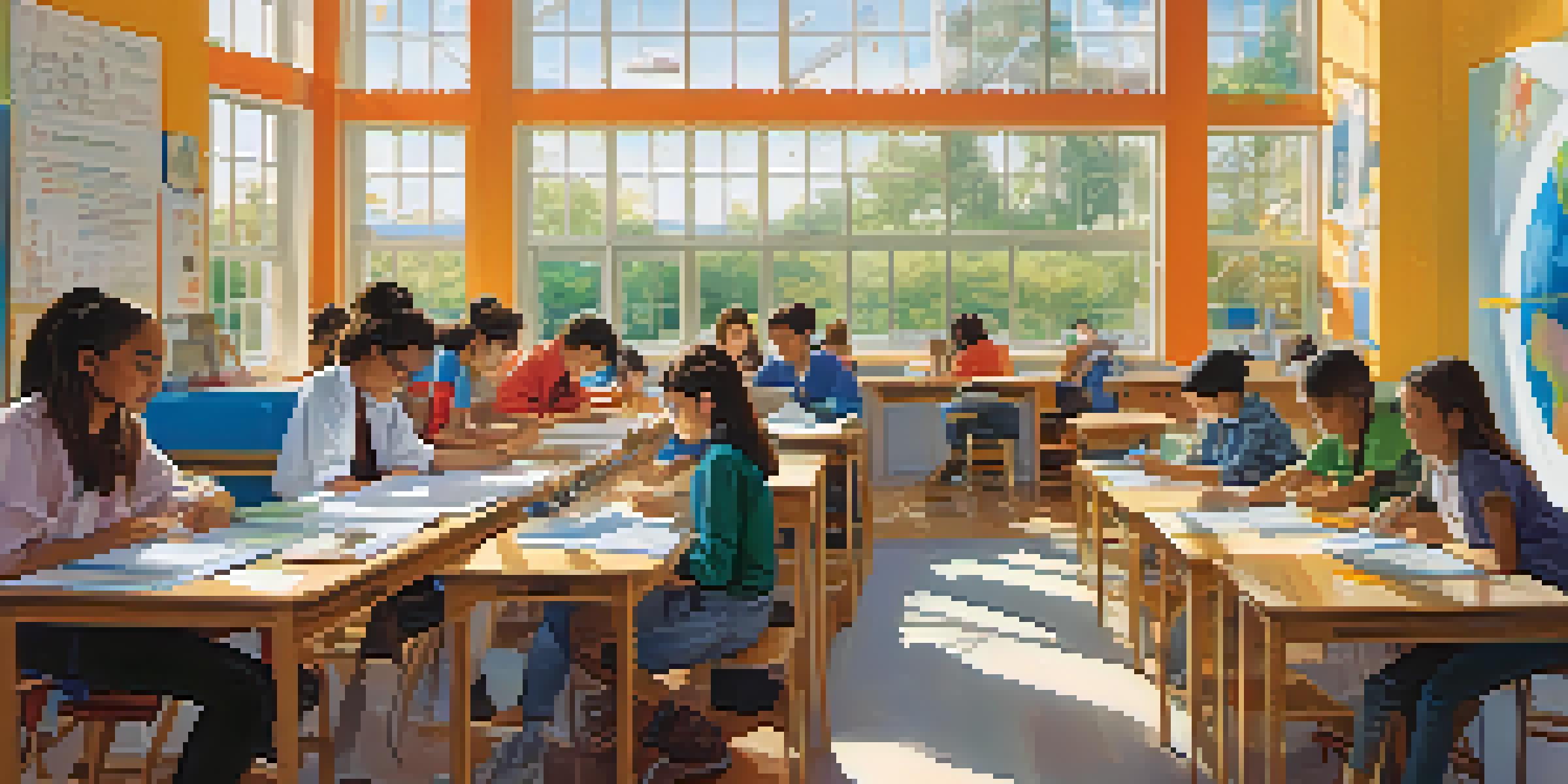The Benefits of Interdisciplinary Learning in STEM Education

What is Interdisciplinary Learning in STEM Education?
Interdisciplinary learning in STEM education involves combining multiple disciplines to create a more cohesive learning experience. Rather than teaching subjects like science, technology, engineering, and mathematics in isolation, this approach encourages students to see the connections between them. For instance, a project on renewable energy could incorporate physics, environmental science, and economics, offering a more rounded perspective.
Education is not the filling of a pail, but the lighting of a fire.
This method allows students to approach problems from various angles, fostering critical thinking and creativity. When students engage with different fields, they not only gain knowledge but also learn to apply it in diverse contexts. This holistic approach prepares them for real-world challenges, where problems rarely fit neatly into one category.
Moreover, interdisciplinary learning reflects the collaborative nature of today’s workforce. In many careers, professionals from different fields must work together to innovate and solve complex issues. By embedding this collaborative spirit into education, we are equipping students with the skills they need to thrive in an interconnected world.
Enhancing Critical Thinking and Problem-Solving Skills
One of the greatest benefits of interdisciplinary learning is its ability to enhance critical thinking and problem-solving skills. When students tackle a project that spans multiple subjects, they are encouraged to analyze information from various perspectives. For example, designing a sustainable city might require knowledge of engineering, environmental science, and social studies, prompting students to think critically about the implications of their designs.

This multifaceted approach allows students to develop a deeper understanding of the material. Instead of memorizing facts, they learn to evaluate evidence, weigh options, and make informed decisions. This analytical mindset is invaluable, not just in academics, but in everyday life as well.
Interdisciplinary Learning Enhances Skills
This approach fosters critical thinking and problem-solving by encouraging students to analyze information from various perspectives.
Furthermore, interdisciplinary projects often present real-world challenges, making learning relevant and engaging. Students are more likely to feel invested in their work when they see its practical applications, which can inspire them to explore further and think creatively about solutions.
Fostering Creativity and Innovation
Interdisciplinary learning naturally fosters creativity and innovation by encouraging students to think outside the box. When students combine concepts from different fields, they can generate unique ideas and solutions that might not emerge in a traditional learning environment. For instance, integrating art with technology can lead to innovative designs in product development or marketing strategies.
The greatest innovations are born from the intersection of disciplines, where diverse ideas can collide and create something new.
This creative blend of disciplines can ignite passion and curiosity in students. When learners see that their knowledge can crossover into various domains, they are more likely to explore and experiment with new ideas. Engaging in such creative endeavors helps build resilience, as students learn that failure can be a stepping stone to success.
Moreover, fostering a culture of creativity prepares students for future careers where innovation is key. Industries today are constantly evolving, and companies seek individuals who can bring fresh ideas to the table. By nurturing creativity through interdisciplinary learning, we are better preparing students to adapt and lead in their future careers.
Improving Collaboration and Communication Skills
Interdisciplinary learning emphasizes collaboration, which is essential for success in any field. When students work on projects that require input from multiple disciplines, they learn to communicate effectively with their peers. This collaborative environment mirrors the teamwork found in most workplaces, where diverse skill sets come together to achieve common goals.
Through group projects, students develop essential interpersonal skills, such as conflict resolution, negotiation, and empathy. Learning to listen to different viewpoints and integrate them into a cohesive strategy is a vital skill in both academic and career settings. For instance, a student may need to work with a peer who specializes in technology while another focuses on design, enhancing their ability to collaborate.
Promotes Engagement and Motivation
Interdisciplinary projects make learning relevant and exciting, leading to increased student investment and motivation.
This focus on teamwork not only prepares students for future careers but also helps build a sense of community within the classroom. When students collaborate, they establish relationships and support systems that can enhance their learning experience. This social aspect of learning can lead to increased motivation and a more enjoyable educational journey.
Promoting Student Engagement and Motivation
Interdisciplinary learning promotes student engagement by making learning more relevant and exciting. When students see the connections between subjects, they are more likely to be invested in their education. For example, a project that combines math and art can captivate students’ attention and inspire them to explore both disciplines further.
Engaged students tend to be more motivated, as they feel a sense of ownership over their learning. When they are actively involved in projects that interest them, they are more likely to put in the effort needed to succeed. This intrinsic motivation can lead to improved academic performance and a deeper understanding of the material.
Moreover, interdisciplinary projects can break down the monotony of traditional learning. By incorporating hands-on activities, real-world scenarios, and collaborative efforts, students are provided with a dynamic learning environment. This variety can keep students focused and excited about their education, which is crucial for long-term learning.
Bridging the Gap Between Education and Real-World Applications
One of the most compelling aspects of interdisciplinary learning is its ability to bridge the gap between education and real-world applications. Students engaged in interdisciplinary projects often tackle issues that reflect current societal challenges, such as climate change or public health. This relevance helps students understand the importance of their education and how it can impact the world around them.
By working on real-world problems, students gain valuable hands-on experience that prepares them for future careers. For example, a project focused on urban planning may involve analyzing data, developing proposals, and presenting solutions to local stakeholders. This kind of practical experience can set students apart in the job market, showcasing their ability to apply their knowledge in meaningful ways.
Bridges Education and Real-World Issues
Students working on interdisciplinary projects tackle societal challenges, gaining practical experience that prepares them for future careers.
Furthermore, this approach encourages students to become informed citizens. By understanding how different disciplines intersect in addressing societal issues, students are more likely to engage as active participants in their communities. This connection between education and real-world impact can inspire a sense of responsibility and empowerment in students.
Challenges and Considerations for Implementation
While the benefits of interdisciplinary learning are clear, implementing this approach in STEM education can present challenges. Teachers may face obstacles such as limited resources, time constraints, and a lack of training in interdisciplinary methods. Overcoming these hurdles requires collaboration among educators, administrators, and policymakers to create supportive environments for innovative teaching.
Additionally, educators must be mindful of the curriculum’s structure and ensure that interdisciplinary projects align with learning objectives. Finding the right balance can be tricky, as educators seek to cover essential content while fostering a rich, integrative learning experience. This demands creativity and flexibility in lesson planning.

Lastly, assessment methods may need to evolve to accurately evaluate student performance in interdisciplinary projects. Traditional testing may not capture the full scope of student learning in these dynamic environments. Instead, educators might consider alternative assessment methods, such as portfolios or presentations, to provide a more comprehensive view of student understanding and skills.